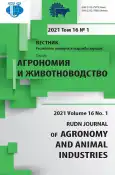State of Rosa acicularis L. coenopopulations in forest park zone of Ekaterinburg
- 作者: Tishkina E.A.1,2
-
隶属关系:
- Botanical Garden of Ural Branch of the Russian Academy of Sciences
- Ural State Forest Engineering University
- 期: 卷 16, 编号 1 (2021)
- 页面: 7-17
- 栏目: Botany
- URL: https://journal-vniispk.ru/2312-797X/article/view/315460
- DOI: https://doi.org/10.22363/2312-797X-2021-16-1-7-17
- ID: 315460
如何引用文章
全文:
详细
The experiments revealed that the studied fragments of Rosa acicularis L. coenopopulation were normal and full-fledged with single-vertex ontogenetic spectra. They are able to form self-sustaining habitats for several generations and spread over a significant territory. Three periods and six ontogenetic states were distinguished in the ontogenesis of Rosa acicularis L. The age structure had three types of spectrum - left-sided, centered, and right-sided. The difference in the ontogenetic structure depends on influence of anthropogenic factor, ecological and coenotic conditions of rose habitats, and variations in climatic conditions. When analyzing the parameters of coenopopulations, we found that the best conditions for existence of Rosa acicularis L. were in the berry pine forest (FCP5) in the park named after Foresters of Russia and reed grass pine forest (FCP1) in Uktus forest park, where the habitats were characterized by high morphological indicators, numbers and high values of the pregenerative fraction.
作者简介
Elena Tishkina
Botanical Garden of Ural Branch of the Russian Academy of Sciences; Ural State Forest Engineering University
编辑信件的主要联系方式.
Email: Elena.MLOB1@yandex.ru
Candidate of Agricultural Sciences, Researcher, Laboratory of Ecology of Woody Plants, Botanical Garden of the Ural Branch of the Russian Academy of Sciences; Associate Professor, Department of Ecology and Nature Management, Ural State Forest Engineering University
202a, 8 Marta st., Yekaterinburg, 620144, Russian Federation; 36, Sibirskiy trakt st., Yekaterinburg, 620100, Russian Federation参考
- Agaoglu YS. Rose oil industry and the production of oil rose (Rosa damascena Mill) in Turkey. Biotechnol. and Biotechnol. Equip. 2000; 14(2):8—15. doi: 10.1080/13102818.2000.10819079
- Balick MJ, Kronenberg F, Ososki AL, Reiff M, Fugh-Berman A, Roble M, et al. Medicinal plants used by Latino healers for women’s health conditions in New York City. Econ. Bot. 2000; 54(3): 344—357. doi: 10.1007/BF02864786
- Pimenov АV, Shemderg МA. Chemical polymorphism of Rosa L. in the contrast climatic conditions. Climate Change, Biodiversity and Boreal Forest Ecosystems: Conference Abstracts. Joensuu, Finland; 1995.
- Geissman TA. (ed.) The chemistry of flavonoid compounds. London — New York: Pergamon-Macmillan; 1962.
- Du H, Zhang X, Zhang R, Zhang L, Yu D, Jiang L. Extraction and the fatty acid profile of Rosa acicularis seed oil. Journal of Oleo Science. 2017; 66(12):1301—1310. doi: 10.5650/jos.ess17006
- Vasfilova ES, Tret’yakova AS, Podgaevskaya EN, Zolotareva NV, Khokhlova MG, Igosheva NI, et al. Dikorastushchie lekarstvennye rasteniya Urala [Ural wild medicinal plants]. Ekaterinburg: Ural University publ.; 2014.
- Gustafsson A, Schroderheim J. Ascorbic acid and hip fertility in Rosa species. Nature. 1944; 153:196—197. doi: 10.1038/153196a0
- Wegg SM, Townsley PM. Ascorbic acid in cultured tissue of briar rose. Rosa rugosa Thunb. Plant Cell Reports. 1983; (2):78—81. doi: 10.1007/BF00270170
- Makarov AA. Lekarstvennye rasteniya Yakutii [Medicinal plants of Yakutia]. Yakutsk: Bichik publ.; 2001.
- Kozhevnikov AP, Kostarev IN. The introduction of woody introduced species into the undergrowth of forest parks in Yekaterinburg. Lesa Rossii i khozyaistvo v nikh. 2018; (4):49—56.
- Kozhevnikov AP, Tishkina EA, Chermnykh AI. Chamaecytisus ruthenicus (Fisch. ex Wol.) Klask. in the forest parks of the Yekaterinburg. Bulletin of Botanic Garden of Saratov State University. 2018; 16(4):30—37.
- Kozhevnikov AP, Kozhevnikova GM, Kapralov AV. Lesnye resursy Urala dlya rekreatsii i poznavatel’nogo turizma [Forest resources of the Urals for recreation and educational tourism]. Ekaterinburg: UGLTU publ.; 2009.
- Rabotnov TA. Questions of studying the composition of the population for the purposes of phytocenology. In: Problemy botaniki. Vyp.1. [Problems of botany. Vol. 1]. 1950; p.465—483.
- Uranov AA. Age spectrum of phytocenopopulations as a function of time and energy wave processes. International Research Journal. 1975; (2):7—34.
- Glotov NV. Assessment of parameters of age structure in plant populations. In: Zhizn’ populyatsii v geterogennoi srede. Ch.1 [Life of populations in a heterogeneous environment. Part 1]. Yoshkar-Ola: Periodika Marii El; 1998. p.146—149.
- Zhivotovsky LA. Ontogenetic states, effective density and classification of plant populations. Russian Journal of Ecology. 2001; (1):3—7.
- Zhukova LA. Intrapopulation biodiversity of herbaceous plants. In: Ekologiya i genetika populyatsii [Ecology and genetics of populations]. Yoshkar-Ola; 1998. p.35—47.
- Smirnova OV, Chistyakova AA, Popadyuk RV, Evstigneev OI, Korotkov VN, Mitrofanova MV, et al. Populyatsionnaya organizatsiya rastitel’nogo pokrova lesnykh territorii (na primere shirokolistvennykh lesov evropeiskoi chasti SSSR) [Population organization of the vegetation cover of forest areas (on the example of deciduous forests of the European USSR)]. Pushchino: PNTc RAN publ.; 1990.
- Alekseev VA. Diagnostics of vital state of trees and forest stands. Russian Journal of Forest Science. 1989; (4):51—57.
- Tishkina EA, Chermnykh AI. Ecological and phytocenotic characteristics of Rosa acicularis L. in Ekaterinburg forest park zone. RUDN Journal of Agronomy and Animal Industries. 2019; 14(1):49—56. doi: 10.22363/2312–797X–2019–14–1–49–56
补充文件










